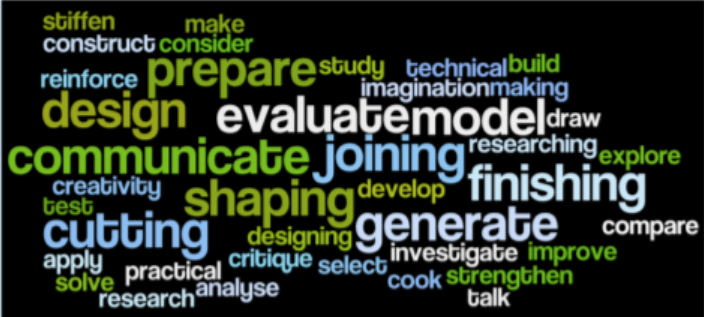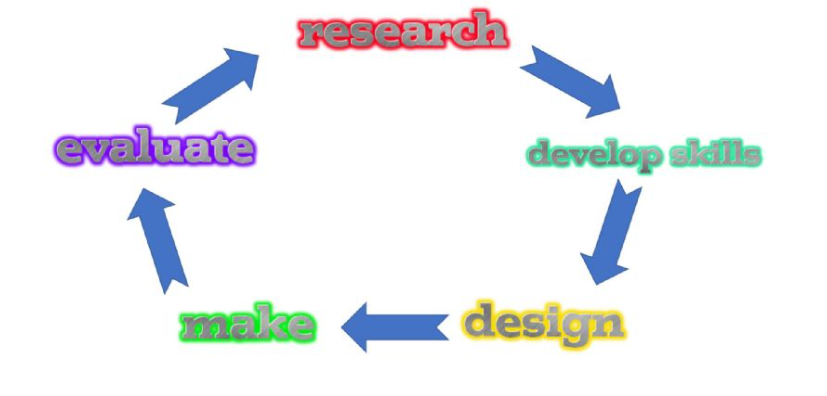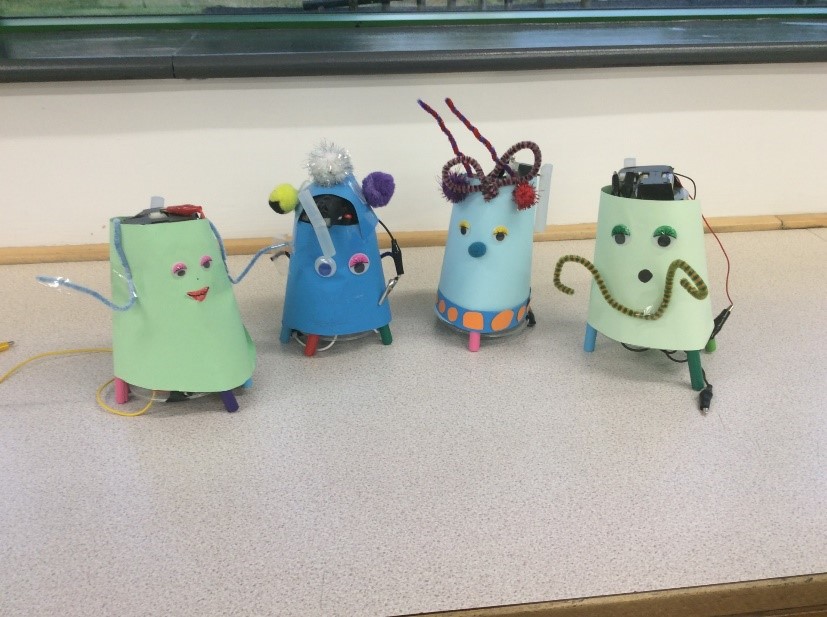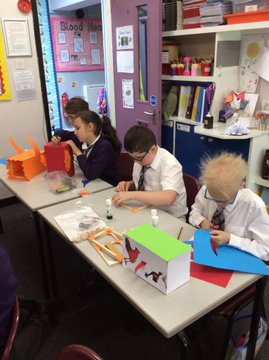Design and Technology

At Hazel Leys, we believe that a comprehensive design and technology curriculum is a knowledge rich curriculum. This curriculum aims to inspire students to think about the important and integral role which design and the creation of designed products play in our society. Wherever we look, evidence of design is all around us. From chairs to hospital equipment, from clothes to websites, from advertisements on the side of a bus to playground equipment, everything has been designed.
The curriculum fulfils the requirements of the National Curriculum for England. This course of study seeks to show how design and technology shapes the world around us. The curriculum is split into three different areas: ‘cook’, ‘sew’ and ‘build’. It is designed so that each year group will complete a unit of work in these three different areas once a year.
Two different ‘aspects’ of design are interwoven into the three areas of study: the environment and sustainability, and enterprise and innovation. These ‘aspects’ acknowledge enduring and contemporary concerns of modern design.
The design process for every product. 
 Intent:
Intent:
Each unit specifies the concepts and skills which the students are expected to learn over the course of a unit. These concepts and skills progress gradually throughout the course of the six years of study.
In ‘cook’ students learn to cook from recipes which gradually build basic culinary skills, culminating in year six with the creation of a mezze-style meal requiring the pupils to produce various small dishes. Whilst studying these practical skills they learn about concepts relating to food such as nutrition, seasonality, food production, transportation and food from different cultures. In each session the children cook from one recipe.
In ‘sew’ students practise using fabric and thread to learn basic sewing techniques to create objects which demonstrate embroidery, appliqué, weaving and plaiting. Concepts such as the properties and creation of different fabrics, fast fashion, industrialisation, waste, recycling and pollution are interwoven into these activities.
In ‘build’ students learn about the creation of structures and mechanical and electrical devices to create products such as cars, moving cards, toys and books. This culminates with year six learning to consider the user in real life, designing a water wall for children in reception. Once again, the practical process of designing and creating a product is interleaved with learning about concepts which have a bearing on what the students make. These concepts, for example force, motion and the properties of materials are often connected with those encountered in the science curriculum.

 Implementation:
Implementation:
At Hazel Leys, the sequence of lessons in the ‘sew’ and ‘build’ areas of study follow a structure to enable the students to become familiar with, understand and practice the process of design: research and investigate, design, make, use and evaluate. The planning for each unit of work specifies the product the children will make, the purpose and user of the product. This specification acknowledges the importance of purpose and user within in the design process.
Throughout the course of the lessons the students explore existing products and their uses, generate ideas and designs by creating drawings and prototypes against criteria which they devise having considered purpose, function and appeal. Evaluation against these criteria concludes the process. All staff know that discussion is an important part of this process, as is consideration of the properties of potential materials and the choice of tools. Learning about fundamental concepts, skills, developments in history and understanding of the influence of key individuals in the field are interleaved into this process-driven structure.
The students’ understanding of key skills and concepts builds from year to year, assessing and cementing prior learning, and therefore the implementation of the curriculum in the given sequence is crucial. The curriculum is designed to be delivered alongside our knowledge rich art, science and history curricula, as parts of it directly relate to areas of knowledge which the pupils acquire in these subjects. Where a unit looks at concepts which are also addressed in these subjects, the design and technology unit is generally taught after units in these other disciplines. This allows the children to approach their study of design and technology with a degree of confidence and ‘expertise’ and to consolidate their knowledge by creating connections between the different disciplines.
It is expected that students’ study will be recorded in sketchbooks. These should be viewed as working documents which evidence the design process and may include notes, annotated photographs, drawings, diagrams and photographs of prototypes and finished work, as well as students’ evaluation of the projects which they undertake. This will ensure that teachers and pupils alike can easily identify progression in knowledge, process and application of skills.
At Hazel Leys, we recognised that the procurement and management of resources is a large part of delivering a design and technology curriculum. Every effort has been made to provide activities which use economic or recycled resources. In addition, the sequence of units ensures that only two year-groups at a time are using the same set of resources so that the purchase of equipment is kept to a minimum. To emphasise the importance of the user/consumer in the process of design there is provision each term for students to take part in an event to celebrate what they have made. This also creates the opportunity for students across different year groups to work together.
EYFS
Through Expressive Arts children are encouraged to explore different media, explore how media can be combined to create different effects and develop a range of skills and techniques experimenting with colour, design, texture, form and function. Children are given daily access to a range of creative opportunities and enjoy our carefully planned and well-resourced creative areas both indoors and out. Children are encouraged to create on both small and large scales and our outdoor environment supports this well. Staff encourage the children to develop their communication and language skills through talking about their creations and sharing these with others to build confidence and raise self-esteem.
Every unit of work covers all of the Early Learning Goals (ELG’s) within the Early Years Framework. With children having opportunities to return to skills in order to develop mastery within art.
 Impact:
Impact:
The impact of this curriculum design will lead to progress across key stages relative to a child’s individual starting point and their progression of skills. Our Design and Technology curriculum will also lead pupils to be enthusiastic learners, evidenced in a range of ways, including pupil voice, product research, final pieces and evaluations. We ensure that children who are achieving well, as well as those who need additional support, are identified, and additional provision and strategies are planned in and discussed with class teachers. Achievements are celebrated in classrooms by displaying cross-curricular work and our whole school design and technology displays.
We will measure the impact of our curriculum through the following methods:
- Annual reporting of standards across the curriculum.
- A reflection on standards achieved against the planned outcomes;
- A celebration of learning for each term which demonstrates progression across the school;
- Pupil discussions about their learning; which includes discussion of their thoughts, ideas, processing and evaluations of work.
- End of unit quizzes
Pupils should leave school equipped with a range of skills to enable them to succeed in their secondary education and be innovative and resourceful members of society. We will be able to evaluate the impact of our Design and Technology curriculum through recording the children’s voice and monitoring the work that they produce.
We expect that children will able to demonstrate:
- An understanding of functional and aesthetic properties of a range of materials and resources.
- An understanding of how to use and combine tools to carry out different processes for shaping, decorating, and manufacturing products.
- An ability to build and apply a repertoire of skills, knowledge and understanding to produce high quality, innovative outcomes, including models, prototypes, CAD, and products to fulfil the needs of users, clients, and scenarios.
- An understanding and application of the principles of healthy eating, diets, and recipes, including key processes, food groups and cooking equipment.
- An appreciation for key individuals, inventions, and events in history and of today that impact our world.
- Recognition of where our decisions can impact the wider world in terms of community, social and environmental issues.
- Self-evaluation skills and reflect on learning at different stages and identify areas to improve.
The end of key stage expectations outlined in the National curriculum for Design and technology.


